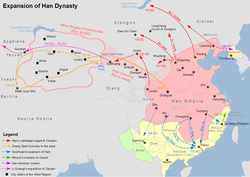Dong'ou
Appearance
Dong'ou | |||||||||
|---|---|---|---|---|---|---|---|---|---|
| 191 BC–138 BC | |||||||||
 The location of Dong'ou kingdom before the conquest of Han Dynasty | |||||||||
| Status | Kingdom | ||||||||
| Capital | Dong'ou (modern Wenzhou) | ||||||||
| Government | Monarchy | ||||||||
| King | |||||||||
• 191–185 BCE | Yao (搖) | ||||||||
• 185–138 BCE | Zhenfu (貞復) | ||||||||
• 138–138 BCE | Wang (望) | ||||||||
| History | |||||||||
• Established | 191 BC | ||||||||
• Defeated by Minyue | 138 BC | ||||||||
| |||||||||
| Today part of | China | ||||||||
Dong'ou (simplified Chinese: 东瓯; traditional Chinese: 東甌; pinyin: Dōng'ōu) also known as Ouyue (simplified Chinese: 瓯越; traditional Chinese: 甌越; pinyin: Ōuyuè), was an ancient Yue kingdom in modern Wenzhou and Taizhou, Zhejiang Province, China. The realm of Dong'ou was given to Zou Yao by Emperor Gaozu of Han in 192 BC. It was almost conquered by Minyue in 138 BC, but the king of Don'gou no longer wished to live in his realm after the incident, and had all his people moved into the Han dynasty.[1][2]
References
- ^ Whiting 2002, p. 145.
- ^ Watson 1993, p. 222.
Further reading
- Taylor, Jay (1983), The Birth of the Vietnamese, University of California Press
- Watson, Burton (1993), Records of the Grand Historian by Sima Qian: Han Dynasty II (Revised Edition, Columbia University Press
- Whiting, Marvin C. (2002), Imperial Chinese Military History, Writers Club Press
- Wylie, A. (1880). "History of the South-Western Barbarians and Chaou-Seen. Translated from the "Tseen Han Shoo," Book 95". The Journal of the Anthropological Institute of Great Britain and Ireland. 9: 78. doi:10.2307/2841871. JSTOR 2841871. OCLC 5545526568.

